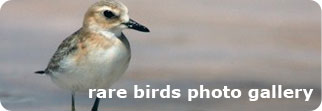Which observations are sent to the Committee
A. Observations of species that have not been recorded before, that is all the species not included in the List of the Birds of Greece, which can be found in the following webpage
B. Observations of species included in the checklist and which:
- Have less than 50 records in Greece. These species are shown below in the List of the Rare Birds of Greece. [Note that in this list are included species that, with the increase of birdwatchers in the last few years, seems to be regular visitors in Greece (e.g. Cattle Egret). Nevertheless, the published or the generally known observations for these species are less than 50. Therefore the Committee encourages observers to send forms regarding all the species in the list, irregardless whether some of them seem less "important" than others.]
- Have been recorded more than 50 times, however their observations are still very important either for they have become very rare and there are very few reports in the last years (e.g. Slender-billed Curlew), or because we still know very little about their status and well documented reports are very important in order to know more about them (e.g. European Storm-Petrel). These species are also included in the list.
- Occur in areas far away from their normal distribution (e.g. in islands never recorded before). As the "normal distribution" we the maps found in G.Handrinos - T. Akriotis "The birds of Greece", 1997.
- Are migratory species and occur in a time period that they are not expected tbe found in Greece. There are reports for early or very late migrants, wintering of summer visitors, or the presence of exclusively winter visitors during the summer. In this case, also, the aforementioned publication is taken as the basic source of knowledge for the phenology of the seasonal presence of species.
- Occur in very large concentrations, in a habitat much different than usual, and, generally, unusual records or records that may create nature protection issues (e.g. individuals or large concentrations of species in new areas, changing of nesting sites, etc).
Explanation: since we can never be absolutely confident in what is "important" for the Categories B3, B4 and B5, the Committee encourages all observers to send all the records they think are important, and explaining why they are so. There is the prospect of gathering large quantities of "non-important" reports. However, the Committee appreciates that, in the present phase, it is very important to collect as many records of the birds of Greece as possible.
Note: every year the Committee will remove from the List of the Rare Birds of Greece those species that will have more than 50 accepted records. It can, nevertheless, add others, if the need to protect wild nature demands it.
Documentation standards: every observation sent to the Committee must be documented with all the facts needed to have a positive identification of the species. The Committee is bound to ask for more evidence in case of very important observations.




